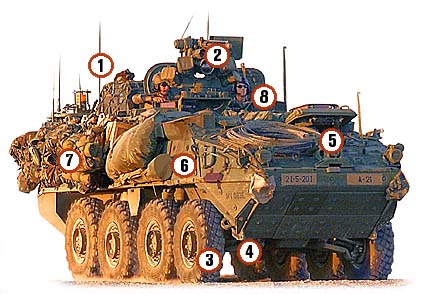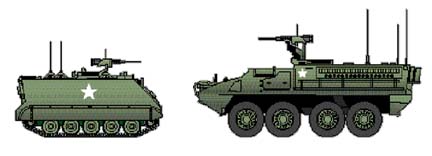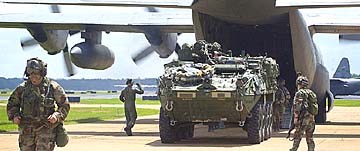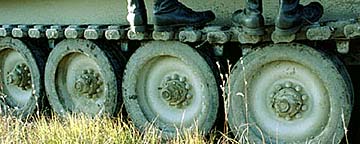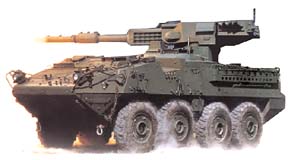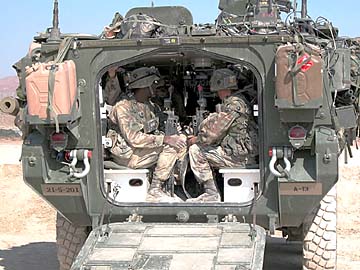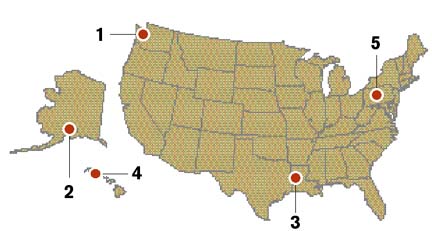
Way of the future or
a waste of money?The Department of Defense will soon decide whether to fund a reorganization of the 2nd Brigade, 25th Infantry Division, at Schofield Barracks into one of six newly created light armored units called Stryker Brigades. Supporters of the concept say Stryker Brigades will be lighter, faster and more mobile than traditional armored forces, filling the operational gap between initially deployed light forces and slower-deploying heavy-armored forces around the world. However, critics of the concept say that it is a waste of money that could endanger soldiers' lives.
PHOTO ILLUSTRATION BY DAVID SWANN / DSWANN@STARBULLETIN.COM
PHOTO BY SCRIPPS HOWARD NEWS SERVICEHigh-tech hardware combined
Named in honor of two unrelated Medal of Honor recipients -- Robert F. Stryker and Stuart S. Stryker -- the 19-ton, eight-wheeled armored vehicle will be built by General Motors Defense Group. Here are some of the vehicle's main components:
with traditional armor features1. FBCB2: Force Battle Command or "tactical internet"allows vehicles to communicate with each other through text messaging and a map network.
2. Kongsberg RWS: The Kongsberg Remote Weapons Station mounts either a .50-caliber machine gun or MK19 40 mm grenade launcher. Both are operated by remote control from inside of the vehicle. The RWS has a camera with a zoom lens that can spot distant enemy forces.
3. Wheels and tires: Unlike most other armored vehicles, the Stryker has wheels and tires instead of metal tracks. The Stryker has four-wheel drive full time, and eight-wheel drive on selection. The tires can be inflated or deflated from inside the vehicle to adapt to surfaces ranging from deep mud to hardtop. It can even be driven on flattened tires, if the tires are shot out, due to hard inner rubber tires within the main outer tires.
4. Self-correcting hydraulics system: Can adjust the Stryker's balance depending on the terrain and position of the vehicle.
5. Driver's hatch and vision port
6. Detroit diesel engine: The Stryker is equipped with a 350-horsepower Caterpillar diesel engine, which is common to the Army's family of medium tactical vehicles. This means some of the same repair parts can be used with many of the Army's vehicles.
7. Crew stowage
8. Commander's hatch
The Stryker will replace
the M-113 APC...
The 40-year-old M-113 Armored personnel carrier, left, will be replaced by the Stryker Infantry Carrier Vehicle, right, as the Army's main troop transporter. Below are the specifications:
M-113 Armored
personnel carrier (APC)Infantry carrier
vehicle (Stryker).50-caliber machine gun Armament Mk 19 40 mm grenade launcher .30-caliber machine gun .50-caliber machine gun 7.62 mm machine gun 4 smoke grenade launchers Aluminum hull with bolt-on armor Armor protection 1/2-inch steel 13 (2 crewmen, 11 troops) Personnel 11 (2 crewmen, 9 troops) 41 mph Maximum speed 62 mph 300 miles Maximum range 300 miles 8 feet, 9 inches Width 9 feet 7 feet, 2 inches Height 8 feet, 6 inches 27,000 pounds Weight 38,000 pounds 16 feet Length 23 feet
...but its size, weight, cost and
The Stryker has produced widely differing opinions throughout the defense industry, with critics as well as proponents. Critics charge that the Army already has a smaller, lighter and cheaper armored vehicle, the M-113 APC. Also, the Stryker's use of wheels, instead of metal tracks like the M-113 APC uses, has led many armor experts to claim that in addition to being more vulnerable to breakdown, the Stryker's tires will not negotiate mud, snow, ice or sand as well as the M-113.
wheels have caused concerns
SIZE
The photo above shows a Stryker exiting from a C-130 transport aircraft, which critics say will not accommodate the Stryker unless equipment and parts are removed from the vehicle due to its size and weight. Because of its oversize dimensions, the Stryker will require a waiver of U.S. Air Force safety rules for transport on a C-130. This waiver allows no more than four men to accompany each vehicle, so the rest of the infantry squad will have to travel in another aircraft. Less fuel and ammunition will also be stowed.
GM DEFENSE
WEIGHT
The Stryker weighs 11,000 pounds more than the M-113 APC. This means that a C-17 transport aircraft can carry five fully combat loaded M-113s but only two fully combat loaded Strykers. Also, the Stryker cannot be airdropped onto the battlefield, while the M-113 can.
COST
The cost of the Stryker program is high: $4 billion to build 2,131 vehicles, which comes out to be about $1.4 million each. The M-113 APC costs $300,000 each. It would cost between $100,000 and $500,000 to update its communications system with digitized systems like those on the Styker.
WHEELS
Since the beginning of mechanized warfare, virtually every tank in every army has been on tracks, not wheels. Metal tracks provide better cross-country mobility and are less prone to damage from poor road conditions or enemy fire. Critics say the Stryker's tires would be easier to immobilize than the M-113's tracks, at left, putting soldiers and crewmen at risk.
GM DEFENSE
Stryker family of vehicles
Two primary models will be built: the Infantry Carrier Vehicle and the Mobile Gun Sysytem. The Mobile Gun System is equipped with a 105 mm cannon, an anti-tank guided missile, two 7.62 mm machine guns and two smoke grenade launchers. There are eight other configurations available based on those two:
GM DEFENSE
Mobile Gun System
>> Anti-Tank Guided Missile Vehicle
>> Mortar Carrier
>> Reconnaissance Vehicle
>> Fire Support Vehicle
>> Engineer Squad Vehicle
>> Commander's Vehicle
>> Medical Evacuation Vehicle>> Nuclear, Biological and Chemical Reconnaissance (NBC) Vehicle
GM DEFENSE
Troops enter and exit through the Stryker's rear access door. Along with the driver and commander, the cabin will allow room for nine soldiers and their gear.
Bases of operation
The Stryker will be the central element in the Army's new Stryker Brigade Combat Teams. The Army is committed to fielding six SBCTs with more than 300 vehicles each. Here is where they will be located, in order of formation:
1. Fort Lewis, Washington 3rd Brigade, 2nd Infantry Division 1st Brigade, 25th Infantry Division
2. Fort Richardson, Alaska 172nd Infantry Brigade
3. Fort Polk, Louisiana 2nd Armored Calvary Regiment
4. Schofield Barracks, Hawaii 2nd Brigade, 25th Infantry Division
5. Pennsylvania The 56th Brigade of the 28th Infantry Division, Army National Guard
Sources: GM Defense Group; Military Analysis Network.com; Global Security.org; U.S. Army Strategic Communications Planning Division; U.S. Department of Defense; 25th Infantry Division Association; hackworth.com; worldnetdaily.com/article.asp?ARTICLE_ID=32898�

